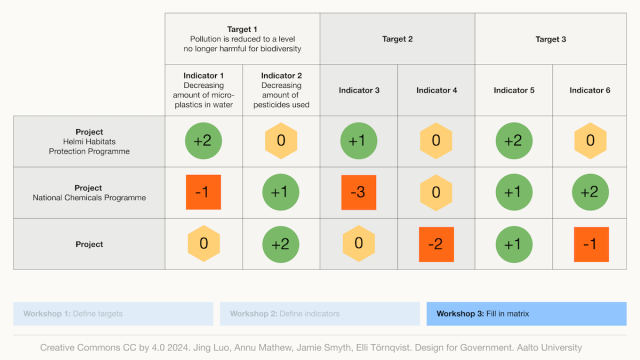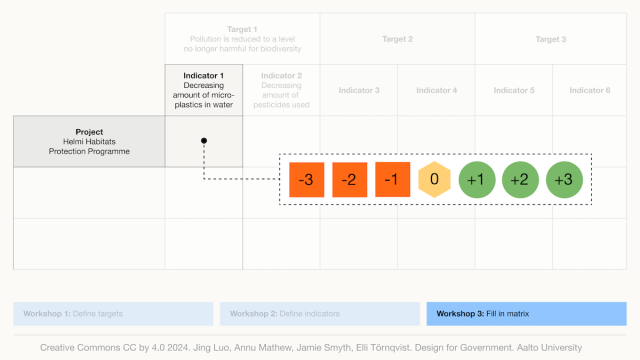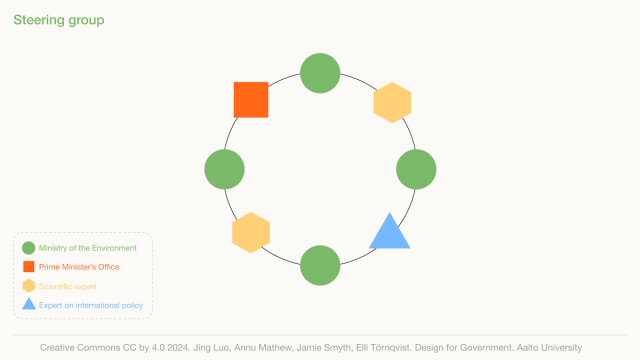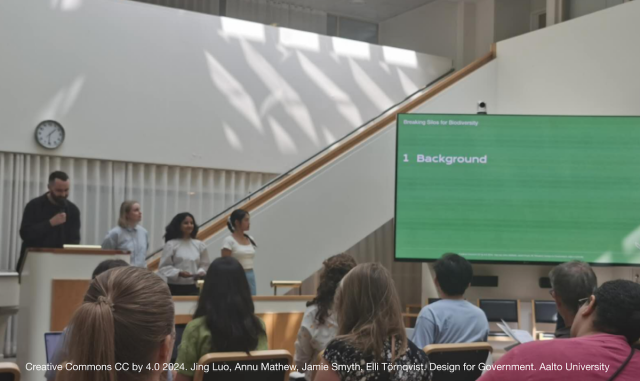This blog post reports on work-in-progress within the DfG course! The post is written by group 1B dealing with the Prime Minister’s and the Ministry of Environment’s brief on ‘Biodiversity policy coherence’. The group includes Jing Luo, Jamie Smyth and Elli Törnqvist from the Creative Sustainability program and Annu Mathew from the Collaborative & Industrial Design program.
Written by Jing Luo
Our Final Journey
During these weeks, we have been working on turning the key entry point we identified during research into a proposal. However, the process of finding the final solution, just like the process of policy-making, is not linear. We went through the process of validating, reversing, finding new entry points, updating, and iterating our ideas, and finally, our exciting proposal is here: Breaking Silos for Biodiversity!

Figure.1 The process of the ideation round table with our stakeholders
Redefining our entry point
On 8 May, we conducted an ideation roundtable with stakeholders to discuss our key entry point, which focused on impact assessment within the Ministry of the Environment. We collected ideas through co-creation. “We don’t have enough Time and resources” and “there is too much data, but also not enough data” were mentioned by the civil servants during the roundtable discussion. After sitting down together to analyze the data, our initial ideas such as increasing the amount of impact assessment or increasing the amount of meeting and communications were rejected as simply there isn’t even enough time. However, we used the barriers we collected to help us think about the system. We concluded that there is no standard for biodiversity projects within the Ministry of the Environment. As we reviewed the insights we had summarized before, we found that project silos could be used as a leverage point in the project-based system. In other words,a standard practice set in the Ministry for biodiversity could help bring every department together to discuss biodiversity topics.
Our Proposal – Breaking silos for biodiversity
Our proposal is a new standard practice for biodiversity projects. It is composed of two parts: a matrix and a steering group. In addition, there will be three workshops to build and fill the matrix. During our desk research, we read the biodiversity policy coherence matrix which has been used in six European cities (Policy Coherence Analysis Report for Six Interlace Cities, Mortelmans D. & Carmen R., 2021). We use this matrix as a benchmark since we found it has the potential to be used for the project silos in the Ministry of the Environment. Let me show you what our filled matrix looks like first. What we have to mention here is that defining these indicators requires biodiversity expertise which we do not have, so please take what we have defined in the matrix as illustrative examples.

Figure.2 Filled project matrix example
Now, let’s take a look at how we apply the matrix in our case. The matrix building process starts with a workshop between the Ministry of the Environment, the Prime Minister’s Office, and external scientific experts to build a high-level biodiversity goal with targets. After setting targets, there’s a second workshop between the Ministry of the Environment civil servants and scientific experts to identify science-based indicators for each target, based on which the projects will be evaluated.
These indicators are then re-evaluated annually by the experts to match the most recent scientific knowledge on biodiversity. Projects will be assessed on a scale from -3 to +3, with -3 being very contradictory to the indicator, +3 indicating that the project works well towards the indicator, and 0 being neutral.

Figure.3 The 7-point scale project measurement standard
As the matrix is filled with projects, we recommend establishing a steering group to provide a comprehensive view of biodiversity. The steering group leads and supports this practice from a pilot stage to a ministry-wide practice. Additionally, it ensures the process of the matrix-filling workshops and analyzes and reports the matrix findings and the results of this practice to the whole ministry.

Figure.4 Our advice on the composition of the steering group
Once the steering group is formed, the steering group can pilot the matrix with five projects of the Ministry of the Environment, which is then monitored and evaluated. The new standard practice can then be implemented successfully in the Ministry and applied to more projects. Our group believes the new standard practice can help pursue government-wide biodiversity policy coherence.
Reflection
We introduced our proposal at the DfG Final Show last week by providing justifications we gathered from our research and references to help people understand. This made our proposal easy to understand, and we got positive feedback from our audience. Within our group, we are so proud of our work!

Figure.5 Group 1B presenting at the DFG Final show!
Personally, the key thing that I have learned is that using critical thinking in the design process is important. Since the system thinking perspective is so important, we need to connect things together and use critical thinking to validate our ideas. For example, when we get so caught up in a new idea, we forget to think about practicability. After discussing with our stakeholders and considering their suggestions on the practicality of our ideas from an outside perspective, our group realized that we needed to change our way of thinking in terms of a systemic approach while always considering the barriers.
Last but not least, when you realize that you’ve been stuck on a problem for a long time and can’t come up with a solution, it’s time to relax, get rid of the problem for a while, and spend some time in nature. Aha moments come when you have a fresh mind!
References
Mortelmans, D., & Carmen, R. (2021). Policy Coherence Analysis Report for Six Interlace Cities.
The DfG course runs for 14 weeks each spring – the 2024 course has now started and runs from 26 Feb to 29 May. It’s an advanced studio course in which students work in multidisciplinary teams to address project briefs commissioned by governmental ministries in Finland. The course proceeds through the spring as a series of teaching modules in which various research and design methods are applied to address the project briefs. Blog posts are written by student groups, in which they share news, experiences and insights from within the course activities and their project development. More information here about the DfG 2024 project briefs.

